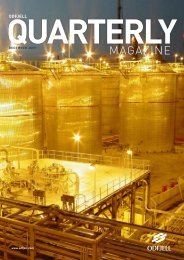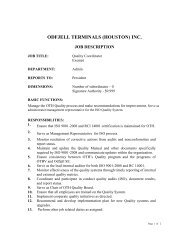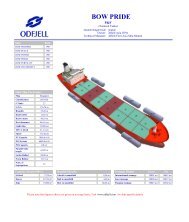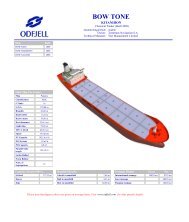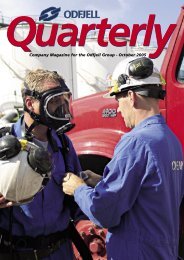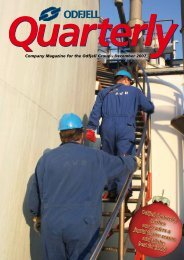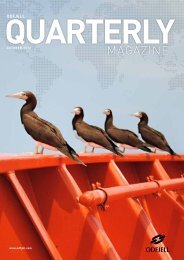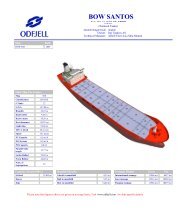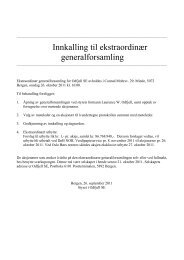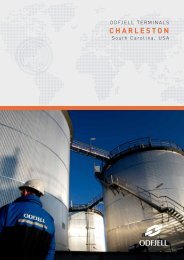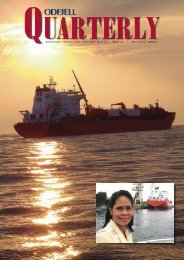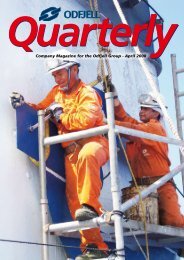Odfjell SE Annual Report 2012
Odfjell SE Annual Report 2012
Odfjell SE Annual Report 2012
Create successful ePaper yourself
Turn your PDF publications into a flip-book with our unique Google optimized e-Paper software.
odfjell group<br />
consolidated financial statements and SIC-12<br />
Consolidation – Special Purpose Entities.<br />
IFRS 10 establishes a single control model<br />
that applies to all entities including special<br />
purpose entities. The changes introduced by<br />
IFRS 10 will require management to exercise<br />
significant judgement to determine which<br />
entities are controlled and therefore are<br />
required to be consolidated by a parent,<br />
compared with the requirements that were<br />
in IAS 27. As a result, the Group has evaluated<br />
the entities to be consolidated pursuant to<br />
IFRS 10 and compared with the requirements<br />
of the current IAS 27.<br />
Within the EU/EEA area, IFRS 10 is effective<br />
for annual periods starting on or after<br />
1.1.2014.<br />
Amendments to IFRS 10, IAS 27 and IFRS 12<br />
related to Investment Entities<br />
Amendments to IFRS 10 imply that enterprises<br />
defined as investment entities no<br />
longer shall consolidate their subsidiaries.<br />
With one exception – subsidiaries engaged in<br />
investment related services to the investment<br />
entity shall be consolidated. Other investments<br />
in subsidiaries, joint ventures and<br />
associates shall be recognised at fair value<br />
through profit and loss. Investment entities<br />
are required to recognise all subsidiaries at<br />
fair value through profit and loss pursuant to<br />
IFRS 10, and present the separate financial<br />
statements as their only financial statements.<br />
The disclosure requirements are extended.<br />
The amendments are effective for annual<br />
periods beginning on or after 1 January<br />
2014, but the EU has not yet approved the<br />
amendments.<br />
IFRS 11 Joint Arrangements<br />
This standard replaces IAS 31 Interests in<br />
Joint Ventures and SIC-13 Jointly-controlled<br />
Entitites – Non-monetary Contributions by<br />
Venturers. IFRS 11 removes the option to<br />
account for jointly controlled entities (JCEs)<br />
using proportionate consolidation. All entities<br />
meeting the definition of a joint venture must<br />
be accounted for using the equity method.<br />
Within the EU/EEA area, IFRS 11 is effective for<br />
annual periods beginning on or after 1 January<br />
2014. The Group expects to account for equity<br />
method in IFRS 11 as of 1 January 2014. It is<br />
expected that changes in IFRS 11 will have<br />
material effect in how <strong>Odfjell</strong> presents its joint<br />
arrangement. Net result will not be changed,<br />
while total assets will be reduced and equity<br />
ratio will increase. During 2013 <strong>Odfjell</strong> plan<br />
to separately show how equity method will<br />
affect <strong>Odfjell</strong>’s financial statement.<br />
IFRS 12 Disclosure of Interests<br />
in Other Entities<br />
IFRS 12 applies for enterprises with interests<br />
in subsidiaries, joint arrangements, associates<br />
and structured entities. IFRS 12 replaces<br />
the disclosure requirements that were<br />
previously included in IAS 27 Consolidated<br />
and Separate Financial Statements, IAS<br />
28 Investments in Associates and IAS 31<br />
Interests in Joint Ventures. A number of<br />
new disclosures are also required, but has<br />
no impact on the Group’s financial position or<br />
performance. Within the EU/EEA area, IFRS<br />
12 is effective for annual periods beginning<br />
on or after 1 January 2014.<br />
IFRS 13 Fair Value Measurement<br />
The standard establishes a single source<br />
of guidance under IFRS for all fair value<br />
measurements, i.e., for requirements of all<br />
standards related to measuring fair value for<br />
assets and obligations. IFRS 13 is effective<br />
for annual periods beginning on or after 1<br />
January 2013.<br />
<strong>Annual</strong> Improvements 2009–2011<br />
IAS 1 Presentation of Financial Statements<br />
The amendments to IAS 1 clarify the difference<br />
between voluntary additional comparative<br />
information and the minimum required<br />
comparative information. Generally, the presentation<br />
of the previous period’s comparative<br />
information will meet the minimum requirements.<br />
The amendments have no impact on<br />
the Group’s financial position or performance<br />
and are effective for annual periods beginning<br />
on or after 1 January 2013, but the EU has not<br />
yet approved the amendments.<br />
IAS 16 Property, Plant and Equipment<br />
The amendment clarifies that major spare<br />
parts and servicing equipment that meet the<br />
definition of property, plant and equipment<br />
are not inventory. The amendment is effective<br />
for annual periods beginning on or after 1<br />
January 2013, but has not yet been approved<br />
by the EU.<br />
IAS 32 Financial Instruments: Presentation<br />
The amendment clarifies that income taxes<br />
arising from distributions to equity holders<br />
shall be accounted for in accordance with<br />
IAS 12 Income Taxes. The amendment is<br />
effective for annual periods beginning on or<br />
after 1 January 2013, but has not yet been<br />
approved by the EU.<br />
Except from IFRS 11 and IAS 19 <strong>Odfjell</strong> expect<br />
that changes will have no or only immaterial<br />
effect on the financial statement.<br />
Note 3 Segment information<br />
The operating businesses are organised<br />
and managed separately according to the<br />
nature of the products and services provided,<br />
with each segment representing a strategic<br />
business unit that offers different products<br />
and serves different markets. The Company<br />
has three reportable business segments:<br />
Chemical Tankers, Tank Terminals and LPG/<br />
Ethylene. The Chemical Tankers involve a<br />
'round the world' service, servicing ports<br />
in Europe, North and South America, the<br />
Middle East and Asia, Australia and Africa.<br />
Our fleet composition enables us to offer<br />
both global and regional transportation. Tank<br />
Terminals play an important operational role<br />
in our cargo-consolidation programme so<br />
as to reduce the time our vessels spend in<br />
ports, reduce thereby emission in port, and<br />
enable us to be one of the world-leaders in<br />
combined shipping and storage services.<br />
<strong>Odfjell</strong> has re-entered into the gas market<br />
in <strong>2012</strong> by acquiring of two modern LPG/<br />
Ethylene carriers. In <strong>2012</strong> this is a small<br />
segment for the Company, but <strong>Odfjell</strong> will<br />
evaluate further investments in the LPG/<br />
Ethylene market.<br />
Pricing of services and transactions between<br />
business segments are set on an arm’s length<br />
basis in a manner similar to transactions with<br />
third parties. Segment revenue, segment<br />
expenses and segment results include transactions<br />
between business segments. These<br />
transactions are eliminated in consolidation.<br />
The Group provide geographical data for<br />
revenue and total assets, as the reliability<br />
measurement criteria cannot be met for<br />
other items. The Group’s activities are mainly<br />
divided among the following regions: Europe,<br />
North and South America, the Middle East<br />
and Asia, Australia and Africa. Vessels and<br />
newbuilding contracts are not allocated to<br />
specific geographical areas as they generally<br />
trade worldwide.<br />
29<br />
odfjell annual report <strong>2012</strong>



